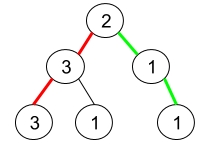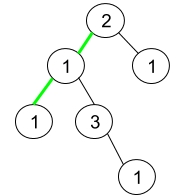Pseudo-Palindromic Paths in a Binary Tree
Given a binary tree where node values are digits from 1 to 9. A path in the binary tree is said to be pseudo-palindromic if at least one permutation of the node values in the path is a palindrome.
Return the number of pseudo-palindromic paths going from the root node to leaf nodes.
Example 1:

Input: root = [2,3,1,3,1,null,1]
Output: 2
Explanation: The figure above represents the given binary tree. There are three paths going from the root node to leaf nodes: the red path [2,3,3], the green path [2,1,1], and the path [2,3,1]. Among these paths only red path and green path are pseudo-palindromic paths since the red path [2,3,3] can be rearranged in [3,2,3] (palindrome) and the green path [2,1,1] can be rearranged in [1,2,1] (palindrome).Example 2:

Input: root = [2,1,1,1,3,null,null,null,null,null,1]
Output: 1
Explanation: The figure above represents the given binary tree. There are three paths going from the root node to leaf nodes: the green path [2,1,1], the path [2,1,3,1], and the path [2,1]. Among these paths only the green path is pseudo-palindromic since [2,1,1] can be rearranged in [1,2,1] (palindrome).Example 3:
Input: root = [9]
Output: 1Constraints:
The given binary tree will have between
1and10^5nodes.Node values are digits from
1to9.
class Solution {
int ans = 0;
int[] freq;
public int pseudoPalindromicPaths(TreeNode root) {
if (root == null)
return 0;
freq = new int[10];
helper(root, 0);
return ans;
}
public void helper(TreeNode root, int oddCount) {
if (root.left == null && root.right == null) {
// For a plaindrome permutation ,we must have atmost 1 odd frequency character
freq[root.val]++;
if (freq[root.val] % 2 != 0)
oddCount++;
else
oddCount--;
if (oddCount <= 1)
ans++;
freq[root.val]--;
return;
}
freq[root.val]++;
if (freq[root.val] % 2 != 0)
oddCount++;
else
oddCount--;
if (root.left != null)
helper(root.left, oddCount);
if (root.right != null)
helper(root.right, oddCount);
freq[root.val]--;
return;
}
}Last updated